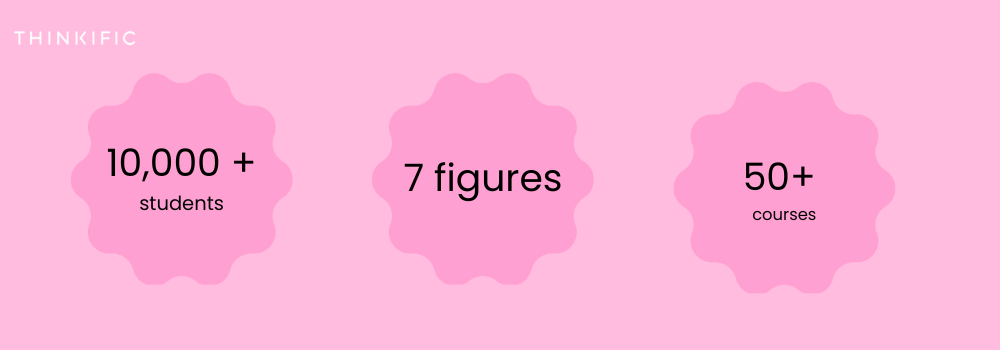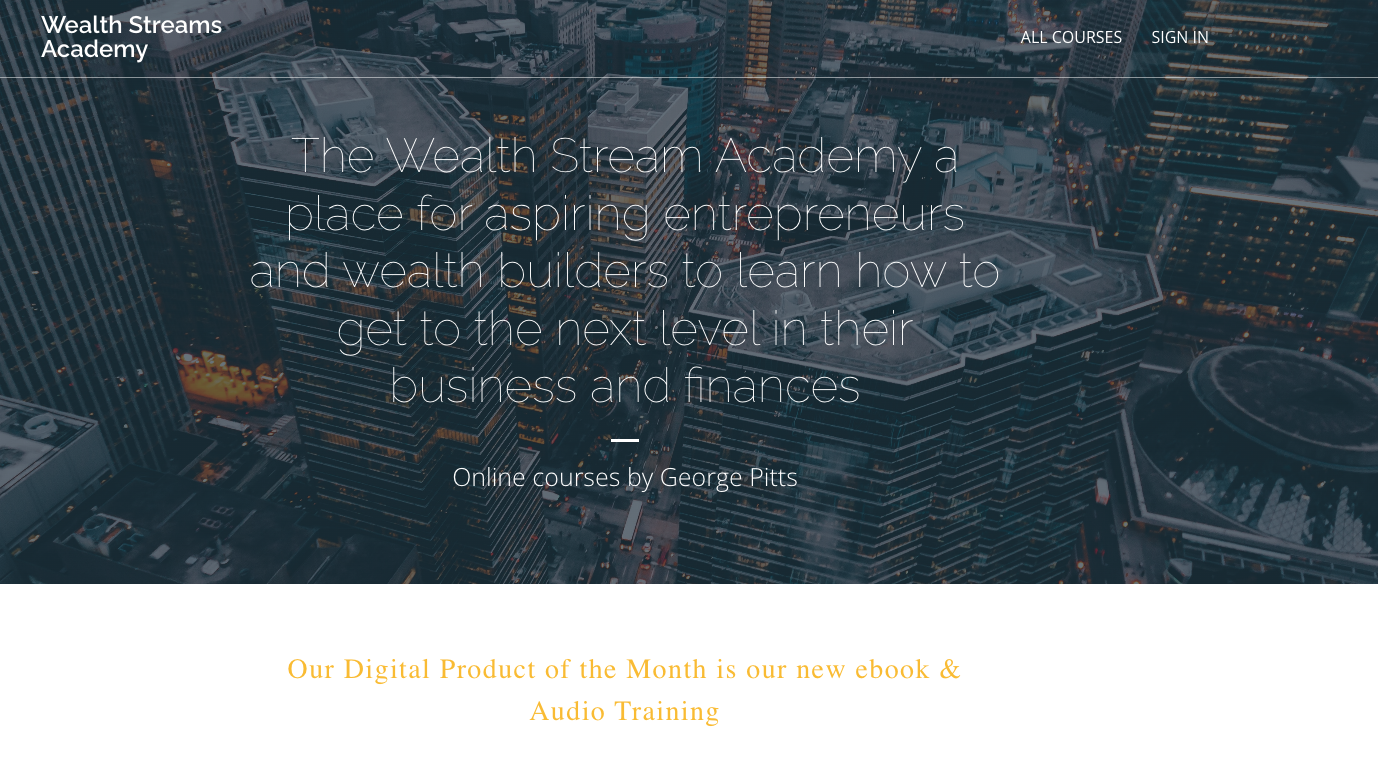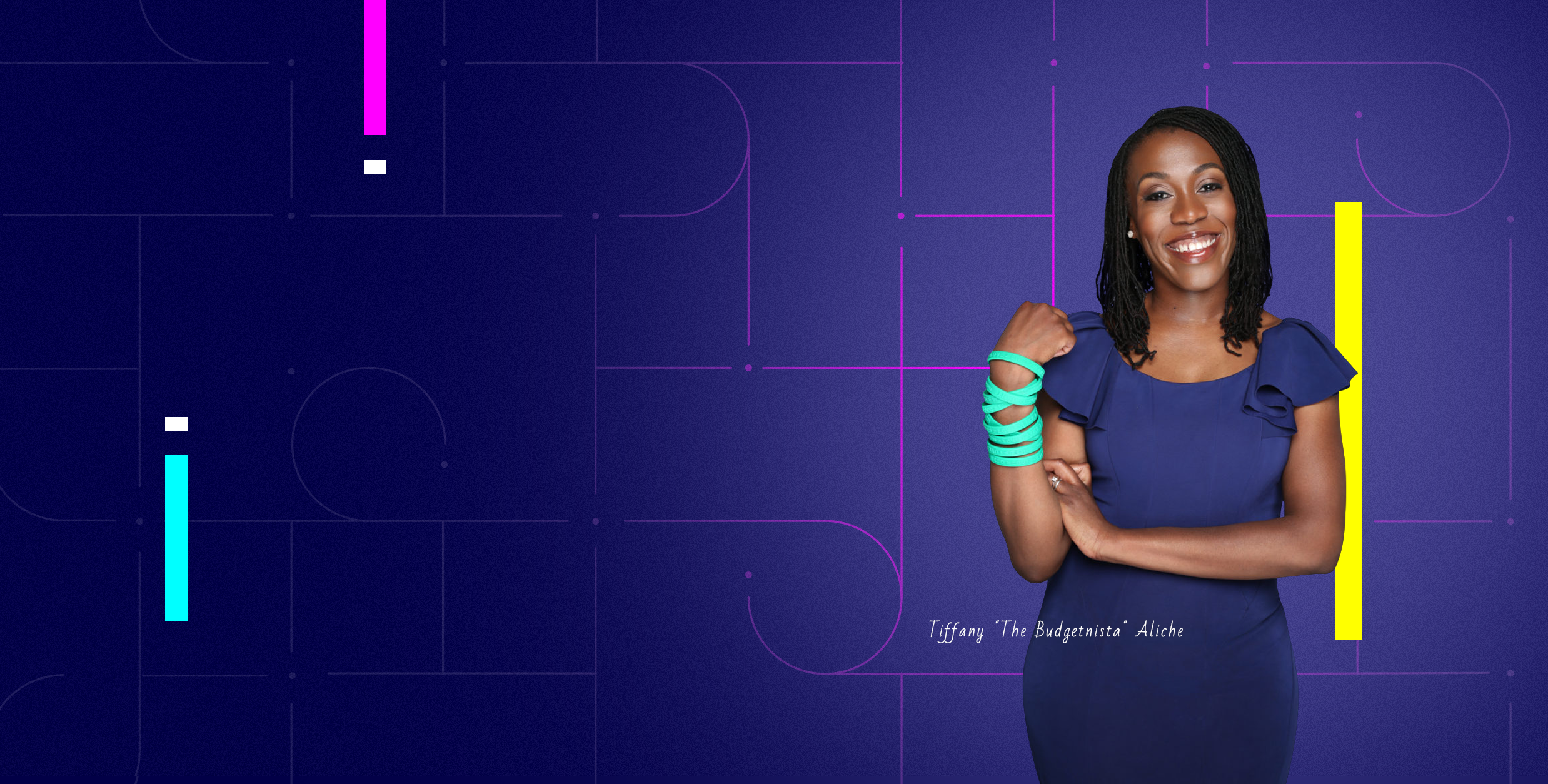In 2017, Texas-based George Pitts was struggling financially.
Despite having a good career as an IT Systems Administrator, he and his partner were living paycheck to paycheck. “We were heavily in debt, had multiple repos, and had a credit score of lower than 500, which is one of the worst in America,” Pitts tells Thinkific.
“We paid all of these people to fix our credit, but nothing changed,” he continues. “Finally, I decided to take a week off work to learn how to do it myself.”
Pitts dove into reading everything he could on the topic through blogs, books, and forums.
“I needed to learn how to fix the situation I was in instead of paying someone else to do it for me.”
Soon, he was able to completely change his financial reality; he built his first home, bought investment properties, and grew his credit score by 300 points.
Now, Pitts is on a mission to help those in Corporate America overcome similar struggles and generate financial abundance through his online course businesses, The Income Academy and Wealth Streams Academy. Currently, he is in the process of merging the two platforms into one on Wealth Streams Academy.

Through his work as a business and personal finance strategist, he teaches individuals how to turn their knowledge into profits through digital products. Since 2018, over 10,000 students have gone through his online programs and he’s created a seven-figure annual income. Here’s how he did it:
Skip ahead:
- He shared his story online
- He listened—and responded—to his audience’s needs
- He nurtured his email list
- He strategically organized his content
- He developed a niche audience
- He created three tiers of courses
- He performed market research
- He built his credibility
He shared his story online
While Pitts was getting himself out of debt and repairing his credit, he developed an eBay store. There, he sold used iPhones and iPhone accessories.
On a live-streaming app called Periscope, which was acquired by Twitter in 2019, he began building an audience. “I decided to go live on the app to share my day, almost like a vlog,” he explains. “I also began sharing about my eBay store, and I had a lot of people asking me questions about it.”
He began getting requests from people to teach them how to create an eBay store. Many wanted to know if he had a course.
“At the time, I didn’t know anything about courses, ebooks, or digital products in general,” he continues. “However, when you get a lot of people asking if they can pay you to teach them something you already do, you start to pay attention.”
He decided to hire a sales coach to teach him how to set up a coaching business. Then, he began doing his research on elearning platforms, and decided to go with Thinkific in 2018.
“The other platforms wanted to nickel and dime me on everything,” he shares. “Thinkific’s packages are simplistic and easy to follow. I love how user-friendly it is, and there is a ton of support. I like knowing that when I need something, I can get a response quickly.”
He listened—and responded—to his audience’s needs
After getting so many requests for Pitts to teach his audience what he knew about eBay, he built and launched his first online eBay masterclass course in 2018. He had 21 students sign up for the course until he cut off registration. “I had imposter syndrome,” he laughs. “I’d never had so much money in my PayPal before, and I started to get nervous. I thought, ‘What if they don’t like it? What if it’s not good? What if they ask for their money back?”
He initially wanted to price his course for $97, but his coach encouraged him to charge more. He had two students sign up for the $97 rate, and when he upped it to $297, he had 19 more people sign up within two days. Once the class was over, he uploaded the recorded videos into Thinkific and sold it as a pre-recorded class—which continued to sell.
Inspired and energized by his recent success, he continued to go live on Periscope, sharing more and more of his story. This time, he opened up about his previous financial struggles and how he learned how to fix his own credit.
Again, people began asking him to teach them what he knew. So, he launched his next course, the Ultimate Credit Repair Masterclass, which generated six figures. “That class has since gone on to have over 7,500 students join over the past couple of years.”
He continued on this way—sharing his story and then responding to his audience’s needs by making courses that answered their questions. When Periscope went down, he switched to sharing content on Instagram. When he got his first 10,000 followers on Instagram, he offered an Instagram growth masterclass. He had 400 people sign up in one day, and his success continued to skyrocket as he shared his experience.
He nurtured his email list
The content he posts on Instagram offers values, tips, and strategies through short-form video content, like reels.
To build his following, he posted three times a day and went live at least once a day. He grew his audience in nine months, from zero to 60,000 followers.
Unfortunately, he was the victim of mass reporting of his account by report bots, so his account was shut down early in 2021. But he didn’t give up; in September of 2021, he began rebuilding his audience and now at 27,000 followers.
This experience of having his Instagram shut down taught him the value of an email list, which he started in 2020, two years into his business. In fact, when he reflects on his online course journey, he wishes he started his email list earlier. To this day, it’s been his most successful form of marketing and he has over 22,000 subscribers.
“With email, everyone who has put in a valid email address is going to receive it,” he says. “With Instagram, you’re only guaranteed to get views from a small percentage of who Instagram decides to show your information to. Plus, if Instagram decides to shut your account down, you still have your email list.”
He strategically organized his content
Pitts and his team don’t just teach people how to start a brand and make money—they teach people how to get their finances in order so that when they introduce digital products, they have a financial foundation. “We want students to have a foundation in place where they can maintain the money that they’re making—and they can then put that money to use to make other streams of income.”
When it comes to content creation, Pitts uses a calendar to outline the different topics that he’s going to cover. Then, he batches his content. “I do everything in a series,” he says. “I treat my brand like a TV show.”
For example, in one season he’ll talk about credit. “I’ll give some educational content, tips, and break some myths around credit,” he says. “Then, I’ll share some testimonials from previous students about learning credit from me, and I’ll do that consistently. Eventually, I’ll make an offer through a call to action. I’ll say, ‘if you’re struggling with this, click the link in my bio.”
In his bio, he’ll include the link to his lead magnet. This lead magnet could be a resource guide, a workshop, or a webinar. This helps him to build his email list, share his teaching style with his students, provide value, and then, eventually, make a course sale.
He developed a niche audience
Pitts describes his audience as those who work a 9-5 in Corporate America but are entrepreneurs at heart.
These folks make good money in their jobs, but want to increase their income through multiple revenue streams. They’ve become certified coaches, but aren’t really sure how to market themselves as a coach. “Many of them live paycheck to paycheck, and even though they make really good money, they’re not in the financial position that they should be in,” explains Pitts. “They’re so burned out because they’re doing so many administrative tasks that they don’t even have time to do the money-making tasks.”
“Our job is to help them get cleaned up from a financial standpoint and give them clarity from an income-generating standpoint,” he continues. “Then, when they come out of our courses, they’re finances are in order and they’re confident in what they do and who they serve.”
He created three tiers of courses
Pitts has three tiers of digital products, and recommends that other course creators organize their business in the way. These tiers include what he calls a chicken offer, a bird offer, and an eagle offer.
He describes a chicken offer as either free or up to $27, and is what allows online course creators to help their audience take their initial growth steps. “Chickens are known for liking table scraps,” he says. “If you throw something out, chickens go and eat it.”
Next is the bird offer, which is a mid-tier offer. “This is for the people that are ready to get off the ground and take flight. It’s going to be priced anywhere from $27-97,” explains Pitts.
Finally, there is the eagle offer—which is the biggest offer. “This is for the people who have vision,” continues Pitts. “Eagles have excellent vision, and since they can see the bigger picture, they’re willing to spend the investment.”
For example, Pitt’s eagle offer is his Courses To Profits course. This six-week training teaches coaches who are stuck in a one-on-one coaching model to build a hybrid program through online courses. It shows students how to create, price, market, and sell their high-ticket digital product.
Course To Profits has chicken and bird offers that lead up to it; the chicken offer is a course template strategy workbook, called Turn Your Knowledge Into Profits With Digital Products, which takes people through the process of identifying what their strong points are and what they can teach, and the bird offer is the course creation masterclass, called the Digital Product Starter Bundle, priced at $97. This teaches students how to create a low-ticket offer in a self-paced format. “Once students go through this course, their next step is the eagle offer: Course To Profits.”
He performed market research
When it comes to pricing courses, Pitts encourages people to consider what value they’re offering people. “Everyone has their own way of pricing their course,” he says. “Some people just put a price on it, other people, like me, do market research.”
For Pitts, market research is key. During this phase, he looks at those with a sizable following. He joins their email list, buys their lower-ticket offers, and looks at the value and level of quality that’s being given.
“I don’t believe in becoming the cheapest, because that’s not valuable. I don’t believe in becoming the most expensive either. I believe in being somewhere in the middle; as long as you have value there, people are willing to invest into that.”
Currently, he offers courses as low as $27 all the way up to $997. The lower-ticket offers are all self-paced, and the higher ticket-offers—such as Course To Profits—are priced higher. To collect payments, he uses Thinkific Payments.
He built his credibility
Pitts is a firm believer that people will only buy your courses if they believe you—and think that you’re a credible source. “If they don’t believe you, they’re not going to invest in you,” he says.
To build his credibility, Pitts says he removed the goal of being perfect from everything that he did. This helped to show his audience that he’s human, too. Plus, sharing his story openly and vulnerably helped people to trust him. “I don’t create any content that makes myself look perfect,” he says. “I put out content to show what I’ve gone through, what I’ve done, and losses that I’ve taken recently.”

According to him, his audience sees that he practices what he preaches. “The biggest way to build your credibility is to talk about what didn’t work and what you failed at,” he says. “That’s where people are; they’re in the stage where they’ve either failed or they’re afraid of failing. They want to see if someone has the blueprint on how they won’t fail.”
His advice for online course creators who have ideas but don’t know where to start is to work backwards.
“If you start at the beginning, you just go down a rabbit hole,” he says. “ Instead, look at the end result that you want to achieve, and focus on how you’re helping your students to transform.”
If you’re ready to help your students transform, too, create your first course on Thinkific today—for free!







